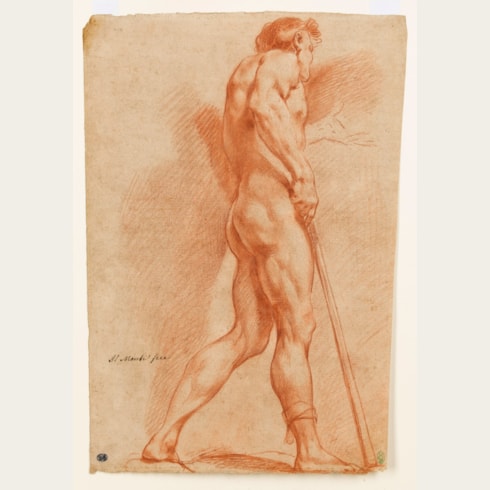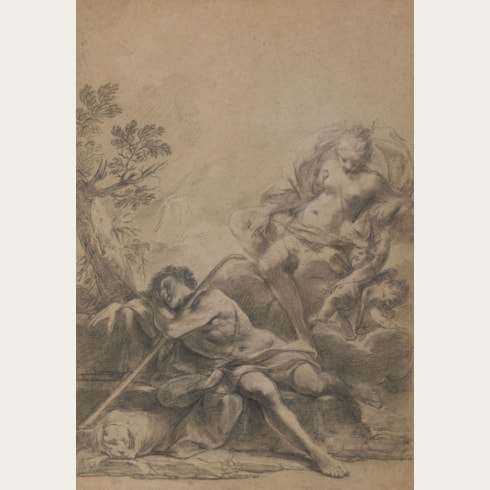Francesco MONTI
(Bologna 1685 - Brescia 1768)
Study of a Male Nude Holding a Pole
Sold
Black chalk and charcoal, with stumping.
Inscribed (in a modern hand) G. B. Piazzetta on the verso.
420 x 293 mm. (16 1/2 x 11 1/2 in.)
Inscribed (in a modern hand) G. B. Piazzetta on the verso.
420 x 293 mm. (16 1/2 x 11 1/2 in.)
This large sheet may be closely compared with a group of seven academic drawings by Francesco Monti, all of similar dimensions and technique, in the collection of the Pinacoteca Nazionale in Bologna. A characteristic of these drawings are the sophisticated, if somewhat artificial, poses and a faintly sketched landscape background (which in the case of this drawing seems to be of an architectural nature), as well as the use of various costume props such as helmets, turbans, knives or staffs. Furthermore, the same model also appears to have posed for several of the drawings of this group. Apart from the seven drawings in Bologna, a handful of other, comparable drawings of male academies in black chalk by Monti are known. These include a study of a Draped Male Nude, Wearing a Helmet and Holding a Dagger, formerly in the Horvitz collection, and a Standing Male Nude in a Hat Holding a Staff, which appeared at auction in 1999. It has been suggested that these drawings, which are all of a similar size, may have once formed part of a large sketchbook.
This distinctive group of drawings of male nudes may be dated to Monti’s Bolognese period, when he was closely associated with the Accademia Clementina in the city, and before his departure for Brescia in 1736. As Mimi Cazort has written, ‘Characteristic of the style which Monti used for these drawings, here defined in terms of the usage of the medium and called the “soft chalk style”, are the smooth blending of the chalk from dark into light areas, with secondary lighting at the edges of the darkest shadow areas and little or no visible hatching; the irregularly accented but complete chalk contour around each figure; and, a particular idiosyncracy of Monti’s, the use of vertically aligned, streaky modeling with precise attention to details of musculature.’
The handling of black chalk in drawings such as this suggest that Monti must have seen and studied the male nude academies of his Venetian contemporary Giovanni Battista Piazzetta (1682-1754), and indeed many of these drawings, including the present sheet, were at one time attributed to the latter artist. As Cazort has pointed out, ‘It is safe to assume that Monti was well acquainted with Piazzetta’s drawings not only because of the Venetian artist’s prestige but because of their mutual involvement during the 1720’s in the last of the Bolognese academies, the Accademia Clementina: Piazzetta was made an honorary member of the Accademia in 1725 and Monti was elected its Principe for the years 1726-27. Since a chief requisite for the honors of the Academy was facility in draughtsmanship, academic drawings in particular, it is likely that Monti knew Piazzetta’s drawings in this mode and emulated them...Piazzetta’s attitude toward the figure and his handling of the chalk was basically a Bolognese rather than a Venetian one which can be traced in a straight line back to the Carracci and forward to the Gandolfi. It may have been precisely this “Bolognese” quality which Monti found so congenial because of his own training in the same tradition.’
This distinctive group of drawings of male nudes may be dated to Monti’s Bolognese period, when he was closely associated with the Accademia Clementina in the city, and before his departure for Brescia in 1736. As Mimi Cazort has written, ‘Characteristic of the style which Monti used for these drawings, here defined in terms of the usage of the medium and called the “soft chalk style”, are the smooth blending of the chalk from dark into light areas, with secondary lighting at the edges of the darkest shadow areas and little or no visible hatching; the irregularly accented but complete chalk contour around each figure; and, a particular idiosyncracy of Monti’s, the use of vertically aligned, streaky modeling with precise attention to details of musculature.’
The handling of black chalk in drawings such as this suggest that Monti must have seen and studied the male nude academies of his Venetian contemporary Giovanni Battista Piazzetta (1682-1754), and indeed many of these drawings, including the present sheet, were at one time attributed to the latter artist. As Cazort has pointed out, ‘It is safe to assume that Monti was well acquainted with Piazzetta’s drawings not only because of the Venetian artist’s prestige but because of their mutual involvement during the 1720’s in the last of the Bolognese academies, the Accademia Clementina: Piazzetta was made an honorary member of the Accademia in 1725 and Monti was elected its Principe for the years 1726-27. Since a chief requisite for the honors of the Academy was facility in draughtsmanship, academic drawings in particular, it is likely that Monti knew Piazzetta’s drawings in this mode and emulated them...Piazzetta’s attitude toward the figure and his handling of the chalk was basically a Bolognese rather than a Venetian one which can be traced in a straight line back to the Carracci and forward to the Gandolfi. It may have been precisely this “Bolognese” quality which Monti found so congenial because of his own training in the same tradition.’
Following a period of study in Modena with Sigismondo Caula, Francesco Monti returned in 1693 to his native Bologna, where he completed his training in the studio of Giovan Gioseffo Dal Sole. The Venetian qualities inherited from Caula remained evident in his work throughout his long and successful career. Among his important early works is the large Pentecost for the church of San Prospero in Reggio Emilia, dated 1713. His career flourished in the 1720’s, when he received a number of significant commissions for history paintings and was elected to a term as principe of the Accademia Clementina.
Together with such artists as Donato Creti, Sebastiano and Marco Ricci, Giambattista Pittoni, Canaletto, Giovanni Battista Piazzetta and others, Monti contributed to a series of large allegorical paintings of imaginary tombs commemorating prominent British noblemen, commissioned by the Irish entrepeneur Owen McSwiny in the late 1720’s and 1730’s from teams of the foremost Venetian and Bolognese painters of the day. Monti also executed several paintings for churches in Bologna and the surrounding region, among them a Death of Saint Peter Martyr for San Domenico in Modena, completed in 1732. Four years later he moved to Brescia to work on the decorations, now lost, of the Palazzo Martinengo. The success of this project led to further commissions, and Monti eventually established a flourishing practice in Brescia. The later years of his career were spent working mainly in Lombardy – mainly in Brescia, Cremona and Bergamo – on a number of large-scale fresco commissions. Among his most significant late works is the extensive decoration of the church of Santa Maria della Pace in Brescia.
Monti is perhaps better known today as a draughtsman than as a painter. As has been noted of the artist, ‘Monti’s drawing style is highly individualistic: it is based on the firm Bolognese academic tradition, but the treatment of the chalk medium, which he preferred, is handled with a particular deftness...His lightness of touch, combined with the “Neo-Mannerist” predilection for attenuated figures, produce a combination of elegance and spontaneity rare in the Bolognese tradition.’ Monti was a prolific and gifted draughtsman, producing both figure studies in black chalk and compositional drawings in red chalk.
Provenance
Richard von Kühlmann, Ohlstadt
Herbert List, Munich (Lugt 4063), his drystamp at the lower right
Acquired in 1972 with the rest of List’s collection of drawings by Ursula and Adolf Ratjen, Vaduz, Liechtenstein, for Wolfgang Ratjen, Munich
The Stiftung Ratjen, Vaduz, Liechtenstein
Flavia Ormond, London, in 1996
Private collection.
Literature
Stuttgart, Staatsgalerie, and elsewhere, Zeichnungen alter Meister aus Deutschem Privatbesitz, exhibition catalogue, 1965-1966, p.15, no.37, illustrated fig.111 (as Giovanni Battista Piazzetta); Mary Cazort Taylor, ‘Some Drawings by Francesco Monti and the Soft Chalk Style’, Master Drawings, Summer 1973, p.162; London, Flavia Ormond Fine Arts Ltd., Italian Old Master Drawings 1500-1850, exhibition catalogue, 1996, unpaginated, no.13; Marzia Faietti and Alessandro Zacchi, ed., Figure: Disegni dal Cinquecento all’ Ottocento nella Pinacoteca Nazionale di Bologna, exhibition catalogue, Bologna, 1998, p.274, under no.92, illustrated (entry by Nancy Ward Neilson); Elena Rossoni, ‘Studi di nudi virili di Francesco Monti alla Pinacoteca Nazionale di Bologna’, Aperto: Bolletino del Gabinetto dei Disegni e delle Stampe della Pinacoteca Nazionale di Bologna, No.3, June 2016, p.36, fig.15.
Exhibition
Stuttgart, Staatsgalerie Hamburg, Kunsthalle and Bremen, Kunsthalle, Zeichnungen alter Meister aus Deutschem Privatbesitz, 1965-1966, no.37 (as Giovanni Battista Piazzetta); New York, Flavia Ormond Fine Arts at Adelson Galleries, Italian Old Master Drawings 1500-1850, 1996, no.13; Stanford University, Cantor Center for Visual Arts, Classic Taste: Drawings and Decorative Arts from the Collection of Horace Brock, March-May, 2000; Boston, Museum of Fine Arts, Splendor and Elegance: European Decorative Arts and Drawings from the Horace Wood Brock Collection, 2009, no.2.






